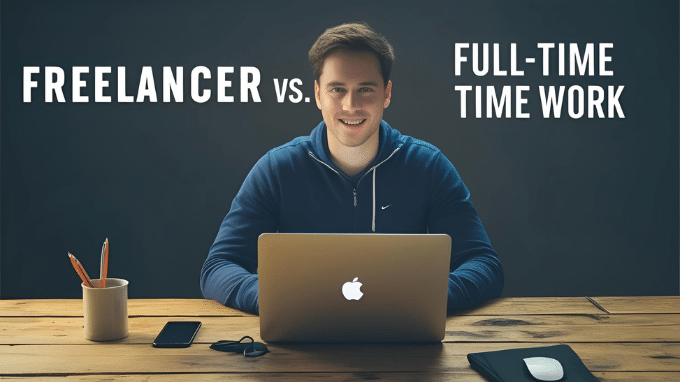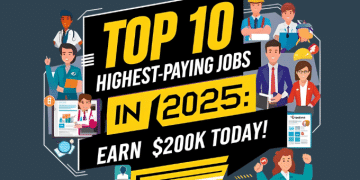Freelancer vs. Full-Time Employee: Who Earns More In 2025?

In 2025, more Americans than ever are stepping back and asking a fundamental question about their work lives: what kind of career actually pays off—in money, in freedom, in well-being? For many, this means comparing freelancing to full-time work not just as job types, but as entirely different ways of living and earning.
Gone are the days when freelancing was viewed as a fallback or a side hustle. Today, independent work is a career in its own right—and a profitable one at that. At the same time, traditional full-time employment continues to offer stability, benefits, and a sense of structure that’s hard to replicate.
So what’s the real story in 2025? Does going solo truly pay more than staying salaried? Or is the 9-to-5 still the best financial bet for most Americans?
In this article, you’ll learn:
- How freelance income vs salary USA is trending in 2025 across industries
- Where the best-paying freelance opportunities are, and what they require
- What hidden costs freelancers face (and the overlooked perks of full-time work)
- How to calculate real income—after taxes, benefits, and time off
- How to make the best decision for your lifestyle, not just your wallet
What the Numbers Say: 2025 at a Glance

Freelance vs. Full-Time Pay: Side-by-Side Comparison
To make this easier to digest, here’s a snapshot of what freelancers and full-time employees typically earn in top fields in 2025:
| Field | Freelancer Avg. Pay (Annual) | Full-Time Avg. Salary (Annual) |
| Web/Mobile Development | $120,000–$200,000+ | $95,000–$130,000 |
| Digital Marketing & SEO | $80,000–$150,000 | $65,000–$100,000 |
| UX/UI & Brand Design | $75,000–$140,000 | $70,000–$110,000 |
| Content Strategy/Writing | $60,000–$120,000 | $55,000–$85,000 |
| Virtual Assistance/Operations | $45,000–$80,000 | $50,000–$75,000 |
| Software Engineering (General) | $100,000–$180,000 | $110,000–$150,000 |
| Healthcare (e.g. RN, PT) | N/A (Rarely freelance) | $70,000–$130,000 |
| Legal (Attorney, Paralegal) | N/A (Typically full-time) | $90,000–$160,000 |
Note: Freelance ranges reflect gross revenue before taxes and expenses. Actual take-home pay may be significantly lower depending on overhead.
Source: Estimates based on data from MBO Partners’ 2024 State of Independence report, Bureau of Labor Statistics (BLS), and Upwork’s Freelance Forward insights.
Read next: Remote Work Salary Trends in 2025
As the table shows, freelancing can out-earn full-time roles—especially in creative, technical, and consulting spaces. But full-time jobs often come with structured raises, equity, and benefits that freelancers must provide for themselves.
The workforce in the U.S. is no longer divided neatly into office jobs and odd jobs. According to a recent report from MBO Partners, over 72 million Americans are freelancing in some capacity this year. That’s nearly half of the U.S. workforce—and the number keeps growing.
Meanwhile, full-time salaried work continues to dominate in sectors like healthcare, education, legal services, and finance. The average full-time salary in 2025 is $59,000 per year, with an additional 20–30% value added through benefits like healthcare, paid leave, and retirement contributions.
Freelancers, however, show greater variance. A freelance graphic designer might bring in $50K, while a software developer charging $120/hour could earn $200K or more annually. But those headline numbers don’t tell the full story—because freelancers foot the bill for taxes, insurance, and time off.
This is why the freelance income vs salary USA conversation requires more than a surface-level comparison. It’s about what you keep, not just what you make.
Things to Consider Before You Choose

It’s easy to look at six-figure freelance stories and think full-time jobs don’t stand a chance. But that misses a key part of the equation: stability, structure, and support. A $65K salaried job with full benefits can be worth as much—or more—than $85K in freelance income when you account for healthcare, retirement, paid leave, and legal protections.
Here’s what you get with most salaried roles:
- Employer-sponsored health insurance (worth up to $12,000/year for families)
- 401(k) matching and retirement contributions
- Paid sick leave, vacation days, and holidays
- Unemployment insurance and legal protections
- Access to mentorship, training, and upward mobility
You show up, do your job, and go home. You’re not chasing payments or juggling multiple clients. For many people, that’s worth its weight in gold.
When you’re comparing freelancing and full-time work, it’s easy to focus on the big numbers—hourly rates, salaries, project fees. But it’s just as important to look at the behind-the-scenes stuff that impacts your actual take-home pay and quality of life. Here are some key factors worth thinking about:
Freelancers Take On More Administrative Work
- You’re in charge of everything—from finding clients to sending invoices to managing your taxes.
- You’ll need to track income and expenses, make quarterly tax payments, and potentially hire an accountant.
- Time spent on admin is time you’re not getting paid for.
Freelancers Have to Handle Their Own Benefits
- You won’t get employer-provided health insurance, retirement plans, or paid time off.
- You’ll likely need to purchase a healthcare plan through the marketplace or go uninsured—which is a big risk.
- Planning for retirement is fully on your shoulders—there’s no 401(k) match or pension to rely on.
Read next: Top 10 Career Tips for 2025
Full-Time Employees Get Built-In Protections
- Your employer handles tax withholding and contributes to programs like Social Security, Medicare, and unemployment insurance.
- You’re covered by labor laws that offer legal protections for wrongful termination, workplace safety, and discrimination.
- If you lose your job, you may qualify for unemployment benefits—something freelancers don’t have access to.
These are often overlooked when comparing freelance income vs salary USA, but they can have a huge impact on your financial health and peace of mind.
Let’s say you’re a freelance social media manager charging $60/hour. That sounds great—until you subtract for:
- Self-employment tax (15.3%)
- Business expenses like software, advertising, and subscriptions
- Time spent unpaid on proposals, invoices, and admin
- Health insurance premiums (easily $400–$700/month)
- Unpaid time off—no vacation pay, no sick leave
When you do the math, $60/hour can quickly feel like $30/hour—or less. That doesn’t mean freelancing isn’t worth it. It just means you need to go in with your eyes open.
Smart freelancers account for these costs in their rates. But early-career independents often overlook them, especially when transitioning from salaried jobs.
The Emotional Side of Each Path
Beyond dollars and cents, there’s how each path makes you feel.
Freelancing Can Feel Like:
- Freedom to work from anywhere
- Control over your hours and workflow
- Creative and entrepreneurial energy
- Stress around income inconsistency and client churn
- Isolation and lack of team camaraderie
Full-Time Work Often Feels Like:
- Security and routine
- Predictable paychecks and job duties
- Built-in social interaction
- Less creative control or flexibility
- Pressure to follow company structures
Your personality matters here. Are you a self-starter? Comfortable with ambiguity? Energized by flexibility? Or do you prefer clear expectations and reliable routines?
Neither option is better—it just depends on you.
Read next: How to Find High-Paying Jobs in the USA: 2025 Career Hacks That Work
How to Choose What Works for You
If you’re still torn between paths, here are some questions to ask yourself:
- Do I have the savings or financial cushion to weather slow months?
- Am I disciplined enough to manage my own schedule and goals?
- Do I thrive on structure—or does it feel stifling?
- Do I want to build a personal brand, or grow inside a company?
Also consider experimenting before committing. Try freelancing on the side while keeping your full-time role. Or take on a short-term contract before diving into independent work full-time.
The great thing about the 2025 job market? There’s room to pivot. Hybrid work and flexible contracts make career changes more accessible than ever.
Redefining What “Success” Means
So—freelance income vs salary USA in 2025? The answer depends entirely on what matters to you.
Freelance opportunities are more plentiful and profitable than ever. But they come with trade-offs. Full-time roles offer security and structure, but may feel limiting if you’re craving independence.
This isn’t about finding the “right” answer. It’s about finding your answer. Think beyond paychecks. Think about how you want your work to fit into your life. Whether you choose freelancing, full-time, or something in between—make sure it supports the kind of life you actually want to build.
You don’t just work for money. You work for meaning, time, growth, and freedom. Choose the path that gets you closer to all four!





